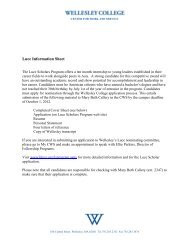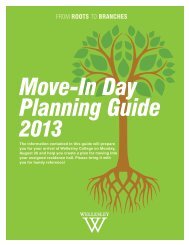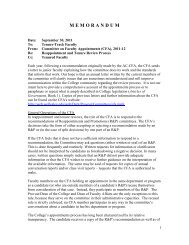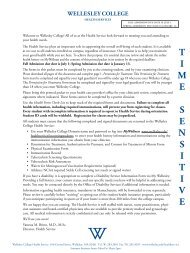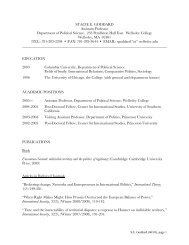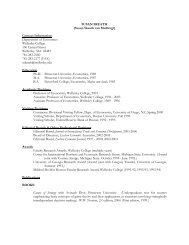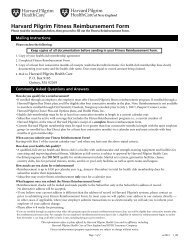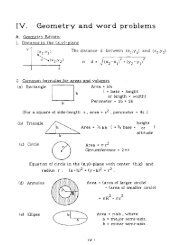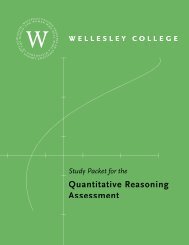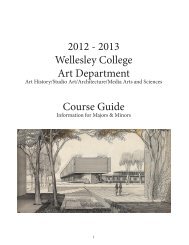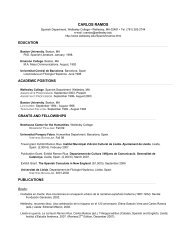1 ECON 202 (1): INTERMEDIATE ... - Wellesley College
1 ECON 202 (1): INTERMEDIATE ... - Wellesley College
1 ECON 202 (1): INTERMEDIATE ... - Wellesley College
You also want an ePaper? Increase the reach of your titles
YUMPU automatically turns print PDFs into web optimized ePapers that Google loves.
<strong>ECON</strong> <strong>202</strong> (1): <strong>INTERMEDIATE</strong> MACRO<strong>ECON</strong>OMIC ANALYSISFall Semester, 2011-2012Joseph P. JoyceRoom 413 PNEDepartment of Economics<strong>Wellesley</strong> <strong>College</strong>Tel: 781-283-2160E*mail: JJoyce@wellesley.eduTopics: Macroeconomic analysis deals with the determination of aggregate output and prices,economic growth, the financial markets, cyclical fluctuations, fiscal and monetary policies, andlinkages with the global economy.Prerequisites: <strong>ECON</strong> 101: Principles of Microeconomics, <strong>ECON</strong> 102: Principles of Macroeconomicsand one math course at the level of MATH 115 or higher.Readings: The textbook for the course is:Mankiw and Ball, Macroeconomics and the Financial System, WorthThe solutions to the questions at the end of each chapter are available on the Sakai site. Supplementaryreadings are also available through our Sakai site.Requirements: The final grade will be based on the results of two mid-term exams (25% each), acomprehensive final exam (40%) and the problem sets (10%).Sakai Site: We will use our site to make announcements, post news stories and problem sets, answerquestions, etc. Please fell free to post any items which you think would be of interest. All class notes,problem sets, and exams are the intellectual property of instructor and should not be given orforwarded to any other party without prior consent.Office Hours: Office hours are on Wednesdays from 2:30 – 3:30 and Thursdays from 2 – 3.Classroom Environment: We meet in the classroom to collectively learn the material. Do not sendtext messages or e-mails, or check your messages. Please refrain from leaving the room unlessnecessary.Honor Code: Members of the course are expected to adhere to the <strong>College</strong>’s Honor Code.Blogs: There are many interesting blogs that cover macroeconomic events and policies, including:Free Exchange (The Economist)Paul Krugman’s blogReal Time Economicshttp://www.economist.com/blogs/freeexchange/http://krugman.blogs.nytimes.com/http://blogs.wsj.com/economics/1
READINGSI. Macroeconomic Concepts and IssuesAug. 30:Aug. 31:National IncomeInflation and UnemploymentMankiw and Ball, Chs. 1; 2; 4.4, 4.6New York Times, 8/16/2011, “On Economy, Raw Data Gets a Grain of Salt”II. Output and Inflation: Long-RunSept. 2: Aggregate SupplySept. 6: Production FunctionsSept. 9: Aggregate DemandSept. 13: Loanable FundsSept. 14: REVMankiw and Ball, Chs. 3; 4.2; 9.3, 9.4: 267-268Krugman and Wells, “The Slump Goes On: Why?” New York Review of Books, 9/30/2010PROBLEM SET I (due Sept. 13)III. Financial MarketsSept. 16: FinanceSept. 20: Bond and Stock MarketsMankiw and Ball, Chs. 15; 16.1-16.5; 17.1-17.2Thaler, “Markets Can Be Wrong and the Price is Not Always Right,” Financial Times, 8/4/2009IV. Growth: Very Long-RunSept. 21, 27: Solow ModelSept. 23: No ClassSept. 30: REVMankiw and Ball, Chs. 7; 8.1-8.3The Economist, “Damage Assessment,” 5/14/09PROBLEM SET II (due Sept. 29)FIRST EXAM: I - IV (Oct. 4)2
V. Output and Inflation: Short-RunSept. 28: Keynesian CrossOct. 5: IS-LM ModelOct. 7: REV(Oct. 11: Fall Break)Oct. 12: REVOct. 14: Macro PoliciesMankiw and Ball, Chs. 9.1-9.2; 10; 11.1The Economist, “Much Ado about Multipliers,” 9/24/30PROBLEM SET III (due Oct. 18)Oct. 18:Oct. 19:Oct. 21:Aggregate Demand and SupplyREVPhillips CurveMankiw and Ball, Chs. 11.2; 12VI. Fiscal PolicyOct. 25:Oct. 26Oct. 28:(Nov. 1:Nov. 4:DeficitsREVDebtTanner Conference)REVMankiw and Ball, Ch. 14.1, 14.3, 14.5The Economist, “The Big Sweat,” 6/11/09PROBLEM SET IV (due Nov. 2)S<strong>ECON</strong>D EXAM: V – VI (Nov. 8)VII. Monetary PolicyNov. 2:Nov. 9:Nov. 11:Nov. 15:Nov. 16:Monetary ExpansionREVFederal ReservePolicy Tools and GoalsREV3
Mankiw and Ball, Chs. 4: Appendix; 13Mishkin, Money, Banking and Financial Markets (2 nd ed.), 2009, Chs. 10: 219-229; 17: 411-418Rudebusch, “The Fed’s Monetary Policy Response to the Current Crisis,” Federal Reserve Bankof San Francisco Economic Letter #2009-17, 5/22/09PROBLEM SET V (due Nov. 18)VIII. InternationalNov. 18:Nov. 22:Nov. 29:Nov. 30:Dec. 2:Dec. 6:Dec. 7:Balance of PaymentsFlexible Exchange RatesFixed Exchange RatesIS/LM/BPNo ClassMacro PoliciesREVMankiw and Ball, Ch. 5.1-5.2The Economist, “Beyond Bretton Woods 2,” 11/4/10PROBLEM SET VI (due Dec. 7)FINAL EXAM: Self-scheduled4



